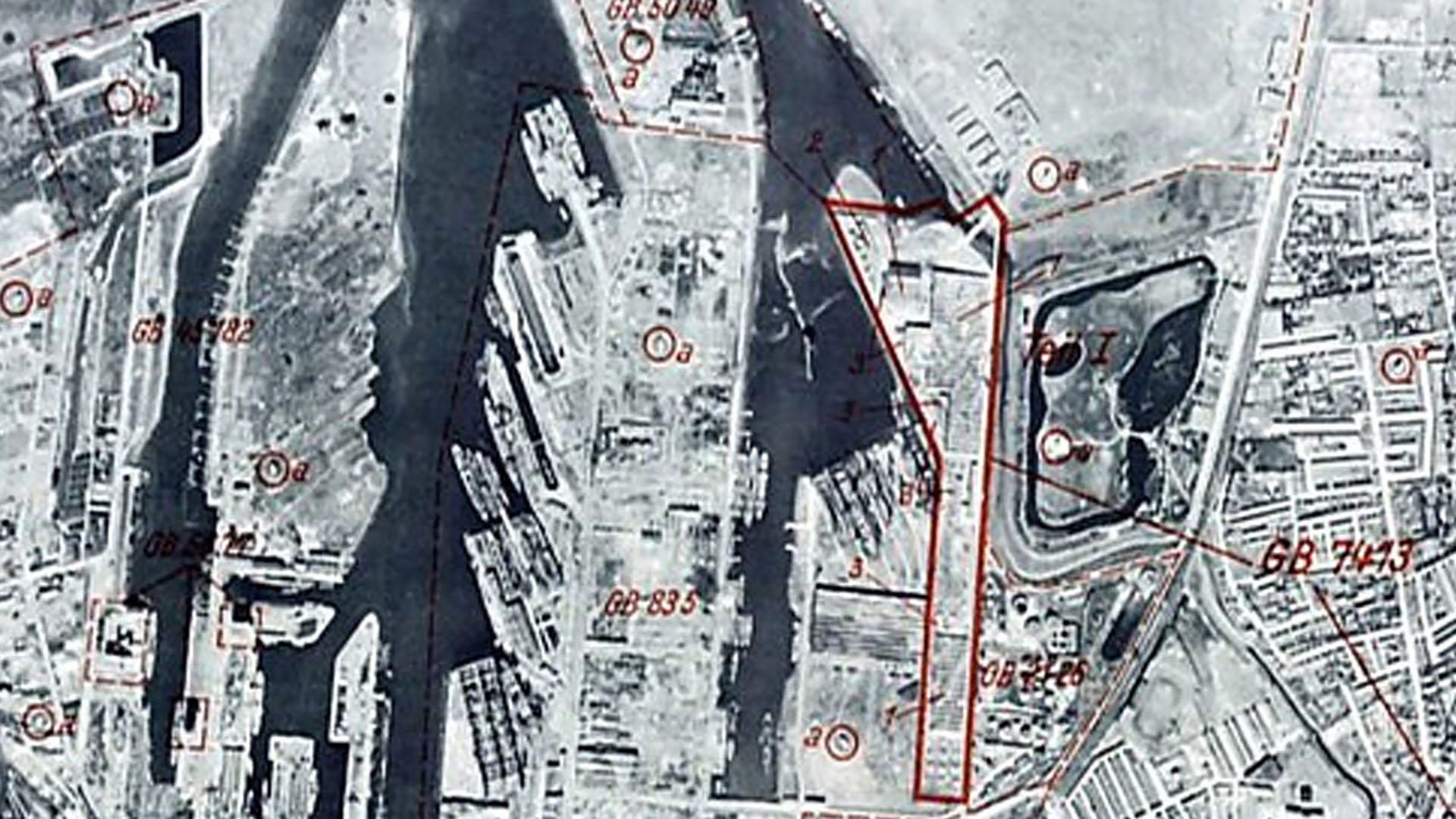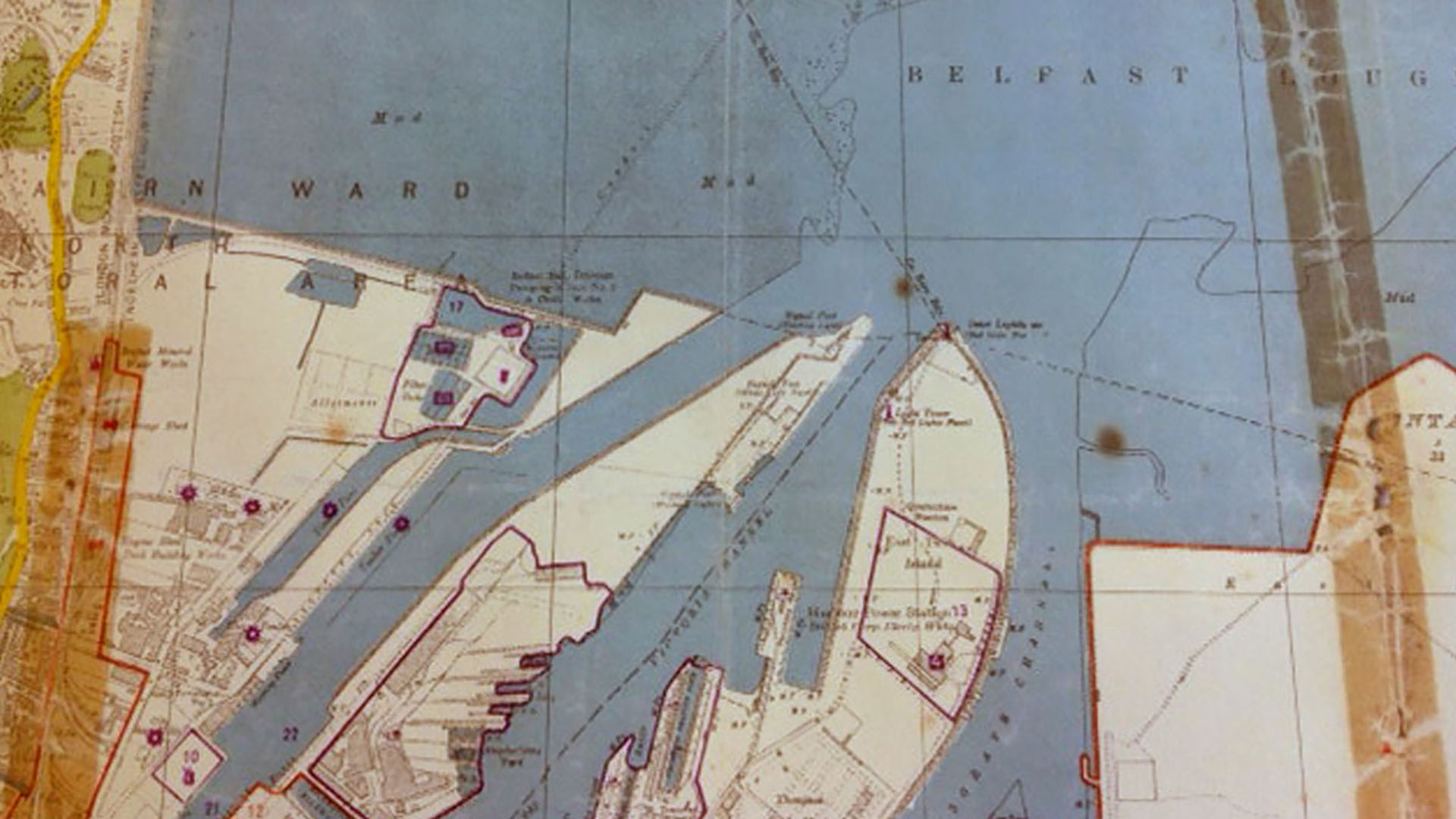Germany was much more prepared for the Belfast Blitz than the Northern Ireland capital. As early as Saturday 30th November 1940, a lone Luftwaffe reconnaissance plane had flown over Belfast. Unobserved, the German plane came in over the Ards Peninsula and reported back from the city.
Belfast was an influential centre for engineering and industry during the war. The Harland and Wolff Shipyard was among the largest in the world. They produced vessels for the Royal Navy including aircraft carriers HMS Formidable and HMS Unicorn. The cruisers HMS Belfast, HMS Penelope, and 131 other naval vessels were also built on the east Belfast site. Harland and Wolff’s yard was one of several operating in Belfast. The city saw the building and conversion of over 3,000 ships and the repair of around 22,000 more. The yards of Northern Ireland’s capital also launched over half a million tons of merchant shipping.
Authorities noted Queen’s Island as a vulnerable point as early as 1929. They noted the Harbour Estate covered 2,760 acres. Harland and Wolff on the east side covered 250 acres, alongside Short and Harland’s aircraft factory and the Harbour Airport. Nearby, were also the city’s power station, the gasworks, telephone house, and Sirocco Engineering.
Mandatory provision of air raid shelters for factory workers only came into practise in the harbour area of Belfast. Westminster stated this was not ample provision, however Stormont still worried about the costs to industry. By 1940, Short and Harland could shelter its entire workforce and Harland and Wolff had provision to shelter 16,000 workers. These shelters were important as these factories had many employees working late at night and early in the morning when Luftwaffe attacks were likely.
The Northern Irish capital was also a centre of aircraft manufacture. Iconic planes like the Sunderland Flying Boat and the Stirling long-range bomber were built in Belfast. The Short and Harland plant employed 20,000 people who had been producing Handley Page Hereford bombers since 1936. As well as the vehicular threat provided by Belfast works, the city also produced tanks, shells, ammunition, rope, and linen.
Luftwaffe Reconnaissance
From July 1940, the Luftwaffe carried out reconnaissance flights over Belfast’s Harbour Estate. They used Heinkel HE111 and Dornier DO17 planes fitted with Zeiss cameras. On Friday 18th October 1940, a plane flew one such mission unobserved by defence systems. They plotted out targets including Das Flugzeugwerk (Short and Harland), die Schiffswerft (Harland and Wolff) and other targets. Photos clearly showed buildings and documents found after the war in Berlin showed the Luftwaffe’s detailed knowledge of Belfast and its lack of defences.
Up to now, we have escaped an attack. So had Clydeside until recently. Clydeside got its blitz during the period of the last moon. There [is] ground for thinking that the… enemy could not easily reach Belfast in force except during a period of moonlight. The period of the next moon from say the 7th to the 16th of April may well bring our turn.
John MacDermott – Minister for Security, Belfast, 24th March 1941
Luftwaffe crews brought back detailed aerial photographs. Each annotation marked a potential Luftwaffe target. The city of Belfast had only 7 anti-aircraft batteries and no searchlights in place. The batteries consisted of 16 heavy anti-aircraft guns and 6 light anti-aircraft guns. To compare with other UK cities, Liverpool’s defence numbered around 100 guns.
Belfast may not have realised how underprepared and poorly defended they were but after that flight Germany knew. Documents obtained after the fall of Berlin show the Luftwaffe had identified 7 prime targets in the city.
- Belfast Power Station.
- Belfast Waterworks.
- Connswater Fuel Depot.
- Harland and Wolff Shipyards.
- Rank and Co. Flour Mill.
- Short and Harland Aircraft Factory.
- Victoria Barracks.
Map of Belfast targets uncovered
To mark the 72nd anniversary of the Luftwaffe attack, Northern Ireland War Memorial Museum displayed a map of Belfast Blitz targets. The museum unveiled the “Stadtplan von Belfast” on 15th April 2013. The copy of an Ordnance Survey Map of Belfast measures 110cm x 70cm. The Luftwaffe target list includes the docks, railway stations, reservoirs, courts and military barracks highlighted in red marker pen. The map has faded over the last seventy years but the German’s “Einzelobjekte” are still clear.
Some of these principal targets will be obvious but others may be less familiar to those who neither know the streets of Belfast nor speak German. All would have been recognisable to the German pilots and navigators in 1941.
- Parlamentsgebäude und Ministerien – Parliament Buildings
- Stadthalle – City Hall
- Werft von Harland and Wolff – Harland and Wolf Shipyards
As well as military and government targets, the map also highlighted some of the hubs of Belfast’s industry. These included the gasworks, ropeworks, and the shipyards and docks. Other buildings listed on the pre-1941 map include Royal Belfast Academical Institution and even a sweet factory.
If you look at it, you can see that it really exposes the vulnerability of Belfast from this map on which areas are highlighted. It could have been picked up by anyone who had been going to Belfast on holiday. They added their own information to it with areas and buildings highlighted. They also marked railways and bridges.
Ciaran Elizabeth Doran – NI War Memorial
The RAF discovered the Luftwaffe map at the end of the war on arrival at Gatow Airfield near Berlin. The map was made available to view through Northern Ireland War Memorial and ScenicNI, a Northern Irish archiving company who held the historic map among their records. With much of the city devastated by the 1941 raids, this map may be one of the last remaining snapshots of the old Belfast that existed before The Blitz.
Belfast had suffered minor bomb damage before 1941. Most likely, these small attacks were by planes missing targets over the River Clyde in Scotland or in the north-west of England.
Belfast in the eyes of the Luftwaffe
As well as aerial photos and the uncovered map, there is also an eyewitness account from the Luftwaffe. On the 60th anniversary of the Belfast Blitz, BBC Northern Ireland interviewed former pilot Gerhardt Becker. In 1941, Becker was a Luftwaffe Oberleutnant based in Northern France. From there, he flew two missions to Belfast with Hindenburg No. 1.
I was definitely one of the first over the target and as I flew in there was no great defence because there were not a great many aircraft over the target at that point. And then naturally as I was over the target, I did pick up flak but I have no sense of exactly how weak or how strong it was, later on, because every bit of flak you get is dangerous.
In his interview, Becker stated that only military objectives were aimed for. He believed that key targets identified across the city were hit. In clear weather, targets were easily identifiable. Looking back on the Belfast Blitz, Oberleutnant Becker signed off with the following words:
A war is the worst thing that can happen to Mankind. The past doesn’t change, it’s just over.
Another Luftwaffe pilot expressed the delight of setting out for a new target after the war:
We were in exceptional good humour, knowing that we were going for a new target.
Luftwaffe targets in Belfast
Some of the industrial and military sites that the Luftwaffe identified before attacking the city in 1941.

